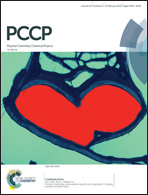Solvent control of charge transfer excited state relaxation pathways in [Fe(2,2′-bipyridine)(CN)4]2−†
Abstract
The excited state dynamics of solvated [Fe(bpy)(CN)4]2−, where bpy = 2,2′-bipyridine, show significant sensitivity to the solvent Lewis acidity. Using a combination of optical absorption and X-ray emission transient spectroscopies, we have previously shown that the metal to ligand charge transfer (MLCT) excited state of [Fe(bpy)(CN)4]2− has a 19 picosecond lifetime and no discernable contribution from metal centered (MC) states in weak Lewis acid solvents, such as dimethyl sulfoxide and acetonitrile.1,2 In the present work, we use the same combination of spectroscopic techniques to measure the MLCT excited state relaxation dynamics of [Fe(bpy)(CN)4]2− in water, a strong Lewis acid solvent. The charge-transfer excited state is now found to decay in less than 100 femtoseconds, forming a quasi-stable metal centered excited state with a 13 picosecond lifetime. We find that this MC excited state has triplet (3MC) character, unlike other reported six-coordinate Fe(II)-centered coordination compounds, which form MC quintet (5MC) states. The solvent dependent changes in excited state non-radiative relaxation for [Fe(bpy)(CN)4]2− allows us to infer the influence of the solvent on the electronic structure of the complex. Furthermore, the robust characterization of the dynamics and optical spectral signatures of the isolated 3MC intermediate provides a strong foundation for identifying 3MC intermediates in the electronic excited state relaxation mechanisms of similar Fe-centered systems being developed for solar applications.
![Graphical abstract: Solvent control of charge transfer excited state relaxation pathways in [Fe(2,2′-bipyridine)(CN)4]2−](/en/Image/Get?imageInfo.ImageType=GA&imageInfo.ImageIdentifier.ManuscriptID=C7CP07838B&imageInfo.ImageIdentifier.Year=2018)


 Please wait while we load your content...
Please wait while we load your content...